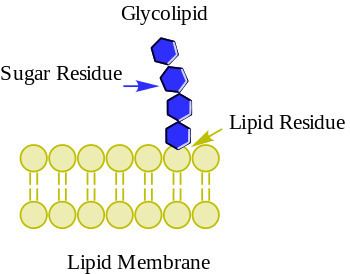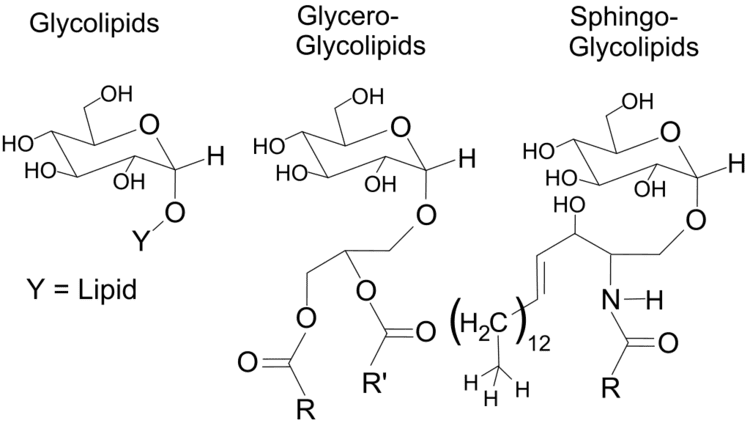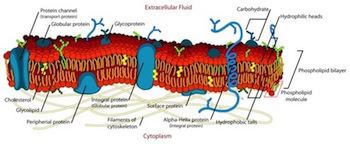 | ||
Glycolipids and cholesterol
Glycolipids are lipids with a carbohydrate attached by a glycosidic bond. Their role is to maintain stability of the membrane and to facilitate cellular recognition. The carbohydrates are found on the outer surface of all eukaryotic cell membranes. They extend from the phospholipid bilayer into the aqueous environment outside the cell where it acts as a recognition site for specific chemicals as well as helping to maintain the stability of the membrane and attaching cells to one another to form tissues.
Contents
- Glycolipids and cholesterol
- 9 dr marwa el kaffas 10 12 2014 metabolism of compound lipids phospho glycolipids
- Structure
- Glycosyltransferases
- Glycoside hydrolases
- Defects in Metabolism
- cellcell Interactions
- Immune Responses
- Blood types
- Types of glycolipids
- References

9 dr marwa el kaffas 10 12 2014 metabolism of compound lipids phospho glycolipids
Structure

The basic structure of a glycolipid is the presence of a carbohydrate monosaccharide or oligosaccharide bound to a lipid moiety. The lipid complex is most often composed of either a glycerol or sphingosine backbone, which gives rise to the two main categories of glycolipids, glyceroglycolipids and sphingolipids. Lipids are non-polar molecules, providing them the capability of interacting with the lipid-bilayer of the cell membrane and anchoring the glycolipid to the surface of the cell. Carbohydrates are used as the ligand component of glycolipids and their structure varies depending on the structure of the molecule it binds to. The carbohydrate contains polar groups that enable the molecule to be soluble in the aqueous environment surrounding the cell. The two molecular groups form a glycoconjugate through a covalent bond referred to as a glycosidic bond. The anomeric carbon of the sugar binds to the hydroxyl group present on the lipid.
Glycosyltransferases

Glycolipids formation is dependent on the activity of glycosyltransferases. Glycoslytransferases are the enzymes responsible for catalyzing the reaction of the covalent bond formation linking the carbohydrate complex to the lipid molecule. It also functions to form the correct oligosaccharide that will be present in the complete structure to act as the receptor for cell signaling. The glycolipid is assembled in the golgi-apparatus and transported to the membrane via vesicles where the lipid remains embedded in the membrane and the carbohydrate is on the outer surface of the cell.
Glycoside hydrolases

Glycoside hydrolases catalyze the breakage of glycosidic bonds. They are used to modify the glycan after it has been added onto the lipid to represent the final oligosaccharide structure. It is also involved in the natural degradation of glycolipids into their non-conjugated forms. The lipids and carbohydrates will then assume their common uses as energy in the body.
Defects in Metabolism
Sphingolipidoses can be associated with defects in metabolism. Sphingolipidoses are a category of diseases that can be associated with the accumulation of sphingolipids from failure to degrade compounds correctly. Sphingolipidoses are typically inherited and have varying effects among the various types of diseases. One notable example is Niemann–Pick disease which can cause pain to, damage to neural networks, and, in severe cases, death.
cell–cell Interactions
The main function of glycolipids in the body is to serve as recognition sites for cell–cell interactions. The sugar moiety of the glycolipid will bind to a specific complementary carbohydrate or lectin, type of cell-surface protein, of a neighboring cell. The interaction of these cell surface markers initiates cellular responses that contribute to activities such as cell recognition, regulation, growth, and apoptosis. Sphingolipidoses can be associated with defects in metabolism.
Immune Responses
An example of how glycolipids function within the body is the interaction between leukocytes and endothelial cells during inflammation. Selectins on the surface of leukocytes and endothelial cells will bind to the carbohydrates attached to glycolipids to initiate the immune response. This binding allows for leukocytes to leave circulation and congregate near the site of inflammation. This is the initial binding mechanism, after which it is followed by expression of integrins which form stronger bonds and allow leukocytes to migrate toward the specific site of inflammation. Glycolipipds are also responsible for other immune responses, notably the recognition of viruses within the body.
Blood types
Blood type are an example of how glycolipids on cell membranes mediate cell interactions with the surrounding environment. There are four different blood types present in humans (A, B, AB, O) that are determined by the sugar moiety attached to a specific glycolipid on blood cells. Blood type A individuals have an N-acetylgalactosamine sugar attachment as the main determining structure, blood type B has a galactose, and Blood type O has no extra addition to the oligosaccharide. Erythroctes have the specific glycolipid for that individuals blood type covering their surface (with AB individuals have both types of antigens). Antibodies are produced in the body and bind to a specific blood type's glycolipids. Blood type A individuals produce antibodies that bind to the B antigen and so forth, so that any cells possessing the corresponding antigen will be targeted by the antibodies.
Types of glycolipids
The following is an incomplete listing of glycolipid types.
